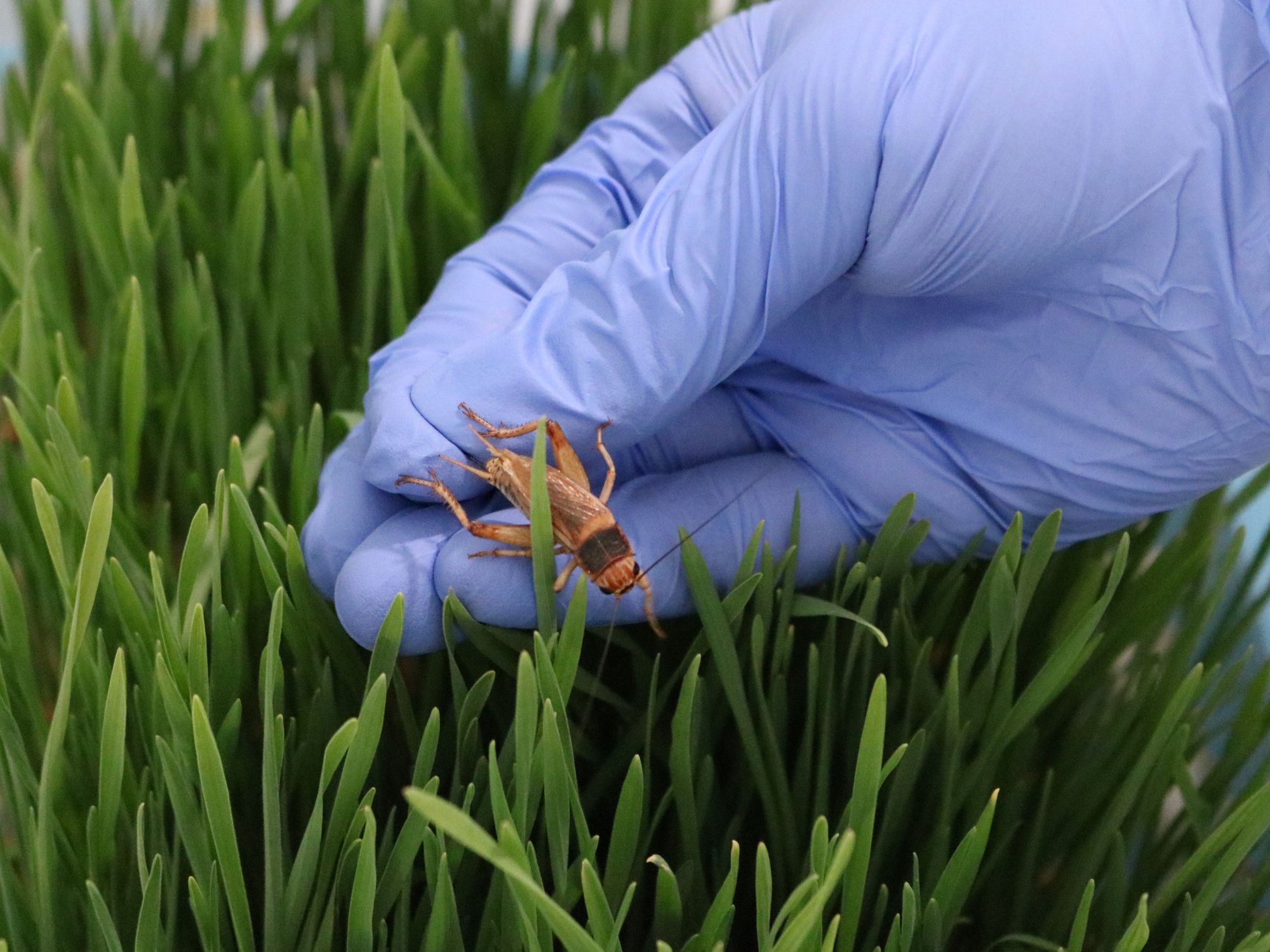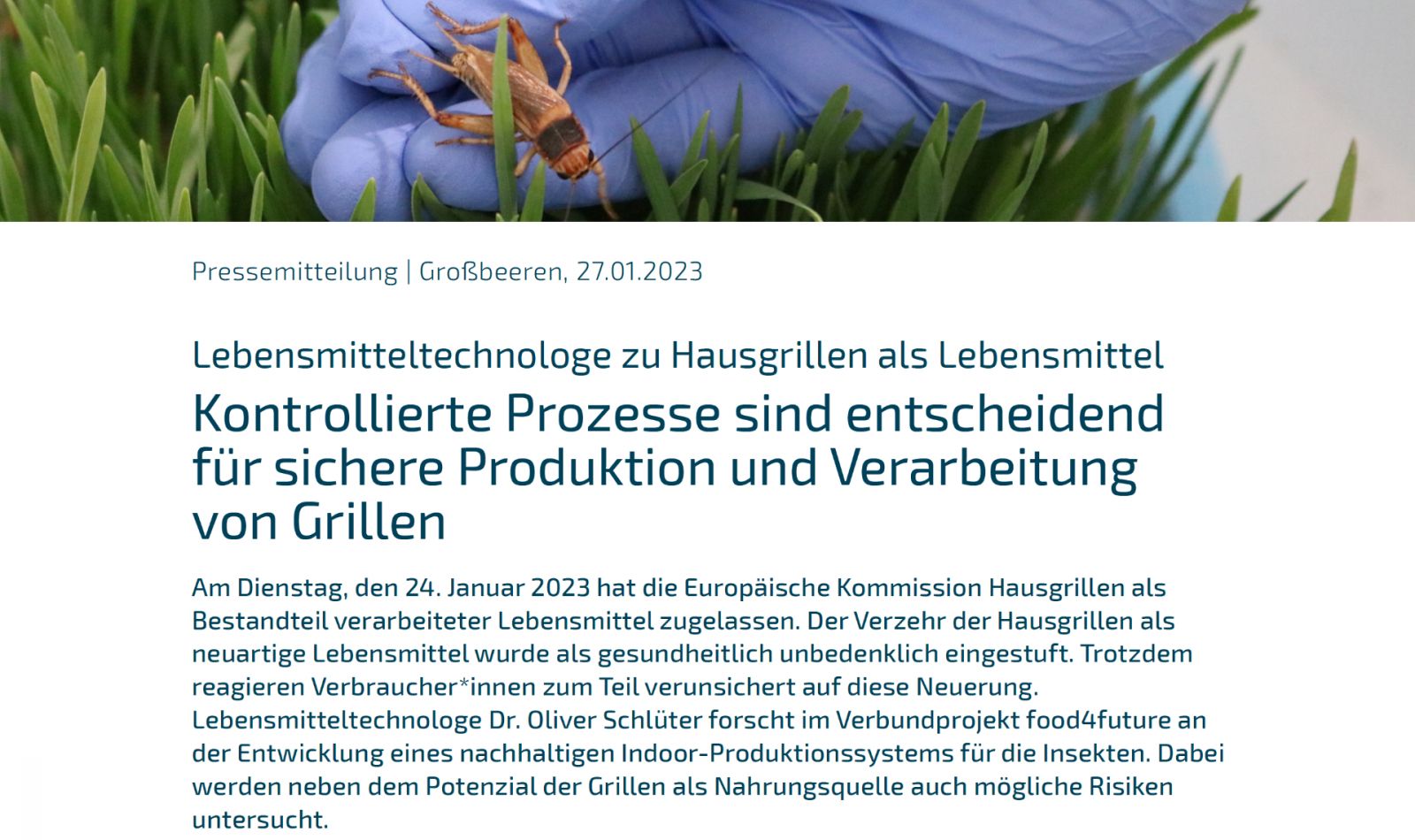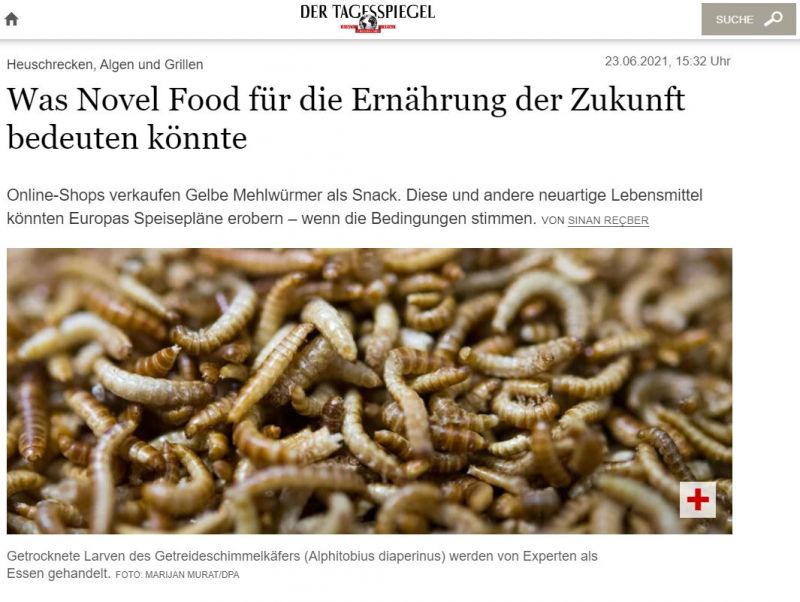Adult crickets (Acheta domesticus) on wheatgrass (Photo: N. Schwab, ATB)
Insects as a food source that are rich in protein, healthy fatty acids and micronutrients, but require only a fraction of the resources of conventional animal husbandry. House crickets (Acheta domesticus) fulfill exactly these characteristics. These insects are not only sustainable, but also extremely versatile - they could play a central role in global nutrition in the future. In this food4future project, we are developing innovative solutions to efficiently cultivate domestic crickets and convert their biomass into tasty and healthy food as well as versatile industrial products.
Our research into the cultivation of house crickets in modular indoor cultivation systems showed that certain key parameters play a decisive role. The influence of increased PAR intensity on growth and quality was investigated and combined with UVB applications. This not only led to an improvement in the survival rate of the crickets, but also to an enrichment of valuable ingredients such as protein and chitin. In addition, the resource efficiency is impressive: only a fraction of the water required for the same amount of pork is needed to cultivate one kilogram of cricket biomass. While pig farming consumes an average of around 15,000 liters of water per kilogram of meat, crickets require less than 5 liters - a clear advantage in times of growing water scarcity and increasing environmental awareness.
In the current funding phase, we are concentrating on further developing this cultivation system. Innovative materials, such as biodegradable plastics, are used for the construction of the compartments in order to further reduce the environmental impact. At the same time, we are researching new processing methods, such as the use of non-thermal processes to extract proteins, fats and chitin in a particularly resource-efficient way. Another focus is on the integration of crickets in co-culture systems in which they are cultivated together with other organisms such as macroalgae or halophytes. These approaches improve resource efficiency, close material cycles and create sustainable value chains. However, the benefits of crickets go far beyond food. Their biomass offers potential for numerous applications, from functional foods and cosmetics to biopolymers such as chitosan. Even their excrement, the so-called “frass”, can be used as an environmentally friendly recycling fertilizer and thus fed back into the cycle.
Macroalgae, halophytes, jellyfish and house crickets play a key role in the sustainable transformation of global agricultural and food systems. Would you like to find out more about our projects and approaches? Discover the world of food4future and find out how we are shaping the food of tomorrow with visionary research and innovative solutions.
Text: O. Schlüter & M. Psarianos, ATB Potsdam
Contact
Leibniz-Institut für Agrartechnik und Bioökonomie (ATB)
Max-Eyth-Allee 100
14469 Potsdam
Website
www.atb-potsdam.de
Project duration
Oktober 2024 - September 2028
Interaction with f4f & associated partners
IGZ, ZMT, DIfE, UB, Hermetia Baruth GmbH, Leibniz InnoHof, Elea Technology GmbH, Algenland UG, Silicann Systems GmbH

Dr.-Ing. habil. Oliver Schlüter is coordinator of the research program “Quality and Safety of Food and Feed” and head of the working group “New Food Resources and Technologies” at ATB. In his research work, Dr. Schlüter focuses on the use of novel technologies in the primary production of food (fruit, vegetables, herbs, spices, meat, edible insects), the processing of fresh products (high pressure, plasma, etc.) and on the non-destructive monitoring of quality and safety aspects (fluorescence image analysis, flow cytometry, etc.).

Marios Psarianos is a scientist at the Leibniz Institute for Agricultural Engineering and Bioeconomy, Potsdam, Germany. His research focuses on novel processes and applications of insects, together with other alternative protein sources, waste utilization, extraction and evaluation of food ingredients.
Psarianos M, Ojha S, Schlüter OK. (2023). Evaluating an emerging technology based biorefinery for edible house crickets. (Frontiers in Nutrition)
doi:10.3389/fnut.2023.1185612
Psarianos M., Ojha S., Schneider R., Schlüter O.K. (2022) Chitin Isolation and Chitosan Production from House Crickets (Acheta domesticus) by Environmentally Friendly Methods. (Molecules) doi:10.3390/molecules27155005
Fricke A., Psarianos M., Sabban J., Fitzner M., Reipsch R., Schlüter O.K., Dreyer C., Vogt J.H-M., Schreiner M. and Baldermann S. (2022) "Composite materials for innovative urban farming of alternative food sources (macroalgae and crickets). (Front. Sustain. Food Syst.)
doi:10.3389/fsufs.2022.1001769
Psarianos M., Fricke A., Ojha S., Baldermann S., Schreiner M., Schlüter O.K. (2022) Effect of Narrowband UV-B Irradiation on the Growth Performance of House Crickets (Foods)
doi.org:10.3390/foods11213487
Psarianos, M., Dimopoulos, G., Ojha, S., Cavini, A. C. M., Bußler, S., Taoukis, P., & Schlüter, O. K. (2022). Effect of pulsed electric fields on cricket (Acheta domesticus) flour: Extraction yield (protein, fat and chitin) and techno-functional properties. Innovative Food Science & Emerging Technologies, 76, 102908.
doi:10.1016/j.ifset.2021.102908
Ojha S., Bekhit A.E.-D., Grune T., Schlüter O. K. (2021) Bioavailability of nutrients from edible insects, Current Opinion in Food Science, Vol. 41, 2021, 240-248,
doi: 10.1016/j.cofs.2021.08.003
Ojha, S.; Bußler, S.; Psarianos, M., Rossi, G., Schlüter, O. K. (2021) Edible Insect Processing Pathways and Implementation of Emerging Technologies. Journal of Insects as Food and Feed, 7(5), 877-900.
doi.org/10.3920/JIFF2020.0121
Fröhling, A.; Bußler, S.; Durek, J.; Schlüter, O. (2020) Thermal impact on the culturable microbial diversity along the processing chain of flour from crickets (Acheta domesticus). Frontiers in Microbiology.
doi:10.3389/fmicb.2020.00884



